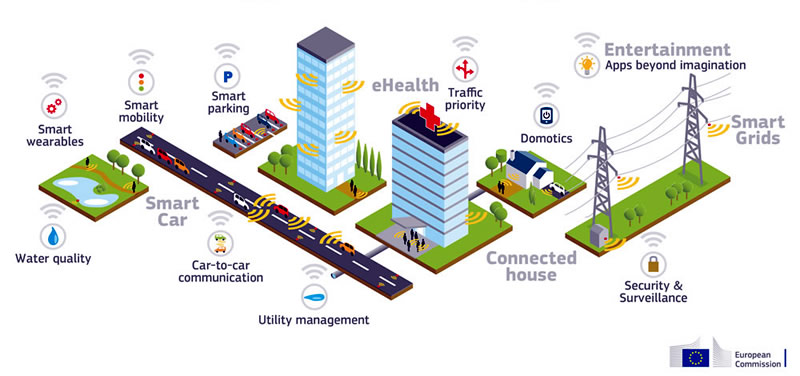
5G telecommunications networks being constructed in many places around the world

Fifth generation mobile telecommunication networks – or 5G – are being created in many places around the world, including the US, China and Europe.
Currently, the majority of mobile device users access either 3G or 4G networks, which both have significantly lower data rates than 5G.
The table below has some basic numbers for how fast each network is – in megabits per second – and dates of when they were operational, or in the case of 5G when it will be.
Mobile telecommunications networks – 3G, 4G and 5G
| 3G | 4G | 5G | |
|---|---|---|---|
| Implementation | 2004-05 | 2006-10 | by 2020 |
| Bandwidth | 2 Mbps | 200 Mbps | > 1 Gbps |
The introduction of 5G networks will enable new, very data-hungry applications, such as driverless cars, which seem to have gone from drawing board to mass production much faster than anyone anticipated.
But then when you consider that many new cars are equipped with advanced driver assistance systems, it’s not really that surprising.
Having said that, driverless cars will not rely on networks for their movement and general operation – all the computing required for that is likely to be done onboard, by computers inside the car.
What the new generation of cars will need and use 5G for is likely to be simple internet connectivity, mainly for information and entertainment purposes.
China is said to be building the world’s largest 5G telecommunications network, which is not all that surprising since it has the world’s largest population.
The country’s spending on 5G network infrastructure is set to reach $180 billion within the next seven years, which is about four times the amount Japan is planning to spend, according to the South China Morning Post.
Among the consumer services predicted to be most in demand on 5G networks are said to be 4K and 8K video.
From the government’s point of view, local councils will be able to use 5G to introduce artificial intelligence systems for public security, traffic management and other services, such as garbage collection and so on.
In total, some analysts estimate that China will have around 600 million people using 5G by 2022, which is about 40 per cent of the total mobile users in the country.
In the US, national carrier AT&T has completed the second test of its 5G network in Austin, Texas.
AT&T is using Ericsson and Intel technology to construct the network and previously ran tests which involved the distribution of DirectTV Now services.
AT&T says it aims to roll out 5G to 20 major metropolitan areas by the end of this year, even though 5G standards have yet to be finalised.
David Christopher, chief marketing officer, AT&T Entertainment Group, says: “Our 5G Evolution in Austin gives our customers a taste of the future.
“With 5G Evolution from AT&T you don’t have to wait to experience endless entertainment possibilities on the next generation network when you have the latest devices.”
In Europe, a new 5G committee, made up of 18 companies and organisations from the business sector and academia, is developing what it calls “network slicing”, which aims to make the most of the capabilities of software-defined networking, network functions virtualization, orchestration, and analytics, to support a variety of vertical industries such as automotive, healthcare, and media.
The project is being funded by the European Commission to the tune of around $9 million.
Members of the group include NEC, Ericsson, Nokia, InterDigital, Orange, and Telefonica, as well as several academic institutions.
Europe is said to be somewhat behind the US and China in the implementation of 5G networks, but that may be because technical standards are still being finalised.
As quoted on the MobileWorldLive.com website, Arun Bansal, Ericsson’s SVP and head of Europe & Latin America, said: “Ericsson is doing 33 trials with operators, almost equally distributed between continents, and we are working with many industries in Europe too.”
He added: “Europe needs to wait until the real 5G specifications are ready and the commercial 5G infrastructure is ready with latency requirements of sub 5 milliseconds.”
